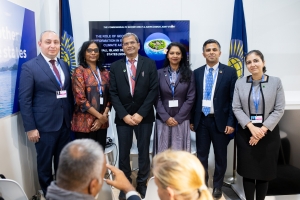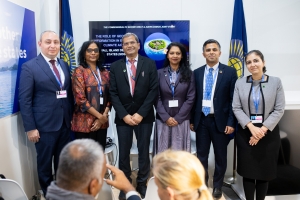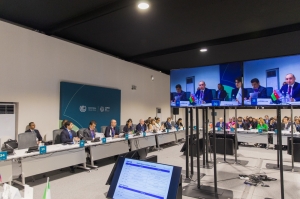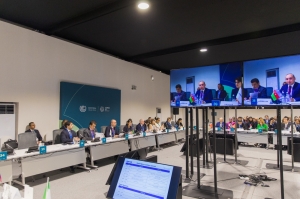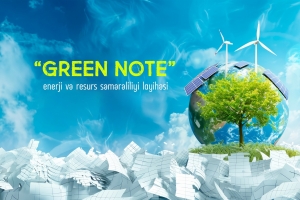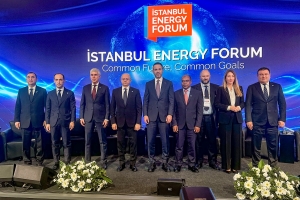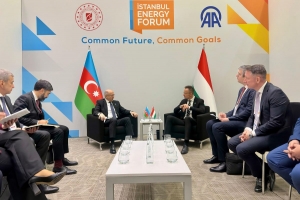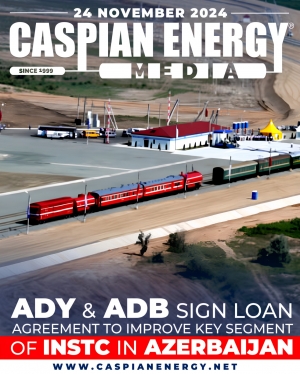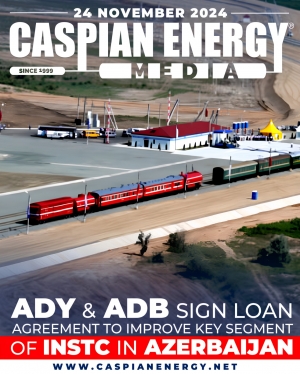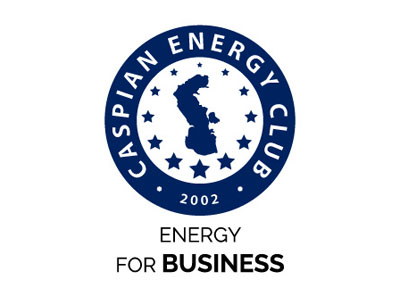Super User
Yığmamız Avropa Kubokunda 1-ci yeri tutub
Cüdoçularımız Yunanıstanın Saloniki şəhərində keçirilən yeniyetmələrin Avropa Kubokunda uğurlu çıxışla yadda qalıblar.
Yığmamız 2 qızıl, 1 gümüş və 5 bürünc medal qazanıb.
Bu nəticə ilə ölkəmiz medal əyarına görə ümumi hesabda 2-ci, oğlanlar arasında isə 1-ci yeri tutub.
Bu barədə “Caspian Energy Media” Gənclər və İdman Nazirliyinə istinadən xəbər verir.
Azercosmos held joint event with the Commonwealth of Nations
The Commonwealth of Nations and Azercosmos organized joint event titled “The Role of Geospatial Information in Enhancing Climate Action in Small Island Developing States (SIDS)”. This event, held within the framework of COP29, highlighted the important role of satellite-based data in mitigating the effects of climate change in Small Island Developing States.
“Caspian Energy Media” reports with reference to the Azercosmos.
Azərkosmos Millətlər Birliyi ilə birgə tədbir keçirib
Millətlər Birliyi Azərkosmos ilə birgə “İnkişaf etməkdə olan Kiçik Ada Dövlətlərində iqlim fəaliyyətinin artırılmasında coğrafi məkan məlumatının rolu” adlı tədbir təşkil edib. COP29 çərçivəsində keçirilən tədbir peyk əsaslı məlumatların inkişaf etməkdə olan Kiçik Ada Dövlətlərində iqlim dəyişikliklərinin təsirlərinin azaldılmasında vacib rolunu vurğulayıb.
Bu barədə "Caspian Energy Media" Azərkosmos-a istinadən xəbər verir.
World Space Leaders Summit Held at COP29
On November 16, Azercosmos, the Space Agency of the Republic of Azerbaijan, hosted the World Space Leaders Summit within the framework of COP29.The summit brought together approximately 80 representatives from the international space community. Attendees included senior officials from Japan, the United States, the Kingdom of Bahrain, Brazil, China, Italy, Norway, Hungary, Saudi Arabia, Türkiye, the United Arab Emirates, and the United Kingdom. The Heads of the United Nations Office for Outer Space Affairs (UNOOSA), the Islamic World Educational, Scientific, and Cultural Organization (ICESCO), the International Astronautical Federation, and the Commonwealth of Nations were also present.
The summit included statements from space agencies on the theme "Joint Efforts for Climate Action: Partnerships, Knowledge, and Data Sharing," reflecting each country’s commitment to addressing climate challenges.
“Caspian Energy Media” reports with reference to the Azercosmos.
COP29-da Kosmik Agentliklərin Liderlərinin Sammiti keçirilib
Azərkosmos, Azərbaycan Respublikasının Kosmik Agentliyi tərəfindən noyabrın 16-da COP29 çərçivəsində Kosmik Agentliklərin Liderlərinin Sammiti keçirilib. Tədbirdə beynəlxalq kosmik ictimaiyyətin 80-ə yaxın nümayəndəsi iştirak edib. Tədbirə Yaponiya, Amerika Birləşmiş Ştatları, Bəhreyn Krallığı, Braziliya, Çin, İtaliya, Norveç, Macarıstan, Səudiyyə Ərəbistanı, Türkiyə, Birləşmiş Ərəb Əmirlikləri, Böyük Britaniyanının kosmik agentliklərinin rəhbər heyəti, BMT-nin Kosmos Məsələləri üzrə Ofisinin (UNOOSA), İslam Dünyası Təhsil, Elm və Mədəniyyət Təşkilatının (ICESCO), Beynəlxalq Astronavtika Federasiyası və Millətlər Birliyi təşkilatının rəhbərləri qatılıb.
Sammitdə kosmik fəaliyyəti olan ölkələrin “İqlim fəaliyyəti üçün birgə səylər: tərəfdaşlıqlar, bilik və məlumat mübadiləsi” mövzusunda hər bir dövlətin uyğunluğunu əks etdirən bəyanatlar dinlənilib.
Bu barədə "Caspian Energy Media" Azərkosmos-a istinadən xəbər verir.
"Green Note" layihəsi çərçivəsində bir məktəbdən toplanan 2 tona yaxın kağız təkrar emala yönləndirilib
Cari ilin aprel ayında Energetika Nazirliyinin dəstəyi ilə Bakı şəhəri 158 nömrəli tam orta məktəbdə "Yaşıl dünya naminə həmrəylik ili" çərçivəsində başladılan "Green Note" layihəsinin birinci mərhələsi yekunlaşıb. Layihə çərçivəsində məktəb şagirdləri və kollektivi tərəfindən təkrar emala göndərilmək üçün 2 tona yaxın kağız toplanıb.
Layihənin məqsədi məktəbdə istifadə olunmuş dəftərlərin və digər kağız məmulatlarının təkrar emala yönləndirilməsi ilə şagirdlər arasında ekoloji mədəniyyətin formalaşdırılması və təbiətin mühafizəsinə töhfə verməkdir.
Bu barədə “Caspian Energy Media” Energetika Nazirliyinə istinadən xəbər verir.
Energetika naziri İstanbul Enerji Forumunda Azərbaycan - Türkiyə “yaşıl enerji” tərəfdaşlığından danışıb
Energetika naziri Pərviz Şahbazov 1-ci İstanbul Enerji Forumu çərçivəsində “Dayanıqlı gələcək üçün çağırışlar və imkanlar” mövzusunda keçirilən nazirlər sessiyasında çıxış edib. Nazir çıxışında artan enerji tələbatını qarşılamaq, iqlim dəyişikliyi ilə mübarizə aparmaq və enerji təhlükəsizliyini gücləndirməklə bağlı müasir enerji çağırışlarının həllində regional və beynəlxalq enerji əməkdaşlığının vacibliyini vurğulayıb.
Bərpa olunan enerjinin inkişafına dair beynəlxalq proqramın bir neçə “yaşıl enerji dəhlizi” layihəsindən ibarət olduğu qeyd edilib. “Azərbaycan - Türkiyə - Avropa”, “Xəzər-Qara dəniz-Avropa” və “Mərkəzi Asiya-Azərbaycan” yaşıl enerji dəhlizlərinin enerji təhlükəsizliyi və enerji keçidində regional enerji əməkdaşlığını gücləndirəcəyi diqqətə çatdırılıb.
Bu barədə “Caspian Energy Media” Energetika Nazirliyinə istinadən xəbər verir.
Türkiyədə Azərbaycan-Macarıstan enerji əməkdaşlığı müzakirə edilib
“İstanbul Enerji Forumu” çərçivəsində energetika naziri Pərviz Şahbazovun Macarıstanın xarici işlər və ticarət naziri Peter Siyarto ilə görüşü olub.
Görüşdə Azərbaycandan qaz tədarükü, Macarıstan şirkətləri ilə neft-qaz sektorunda əməkdaşlıq və “Xəzər-Qara dəniz-Avropa Yaşıl Enerji Dəhlizi” layihəsinin icrası, həmçinin Birgə Müəssisənin fəaliyyəti əsas müzakirə mövzusu olub. “Yaşıl Enerji Dəhlizi”nin texniki-iqtisadi əsaslandırmasının cari vəziyyətinə və Bolqarıstanın layihəyə qoşulmasına dair fikir mübadiləsi aparılıb. Həmçinin Azərbaycan və Macarıstan arasında enerji üzrə İşçi Qrupunun fəaliyyətinə də toxunulub və növbəti iclasın 2025-ci ildə keçiriləcəyi qeyd olunub.
Bu barədə “Caspian Energy Media” Energetika Nazirliyinə istinadən xəbər verir.
Azərbaycan “Şimal-Cənub” dəhlizinin bir hissəsinin bərpası çərçivəsində ADB ilə kredit sazişi imzalayıb
“Azərbaycan Dəmir Yolları” QSC və Asiya İnkişaf Bankı (ADB) regional əlaqələrin gücləndirilməsi məqsədilə “Şimal-Cənub” dəhlizinin Azərbaycandakı əsas hissəsinin bərpa edilməsi üçün 131,5 milyon ABŞ dolları məbləğində kredit sazişi imzalayıb.
Müqaviləni “Azərbaycan Dəmir Yolları” QSC-nin rəhbəri Rövşən Rüstəmov və ADB-nin Azərbaycandakı nümayəndəliyinin rəhbəri Sunniya Durrani-Camal imzalayıblar.
Müqaviləyə əsasən, borcalan maliyyə dayanıqlılığının qorunub saxlanması üçün bazar risklərini, o cümlədən adekvat borc xidmətlərinin əhatə dairəsini, həmçinin inflyasiya, valyuta və faiz dərəcəsi risklərini əhatə etməklə yanaşı, yük və sərnişindaşıma tariflərini müntəzəm olaraq tənzimləməlidir.
Азербайджан подписал с АБР кредитное соглашение в рамках реабилитации участка коридора Север–Юг
ЗАО "Азербайджанские железные дороги" (АЖД) и Азиатский банк развития (АБР) подписали кредитное соглашение на сумму 131,5 млн долларов США для улучшения ключевого звена коридора Север–Юг в Азербайджане с целью усиления региональной связности.
Соглашение подписали глава АЖД Ровшан Рустамов и глава представительства АБР в Азербайджане стала Сунния Дуррани-Джамал.
По соглашению, заемщик должен обеспечить регулярную корректировку тарифов на грузовые и пассажирские перевозки, чтобы позволить AЖД поддерживать финансовую устойчивость, покрывая рыночные риски, включая адекватное покрытие обслуживания долга, а также инфляционные, валютные и процентные риски.





